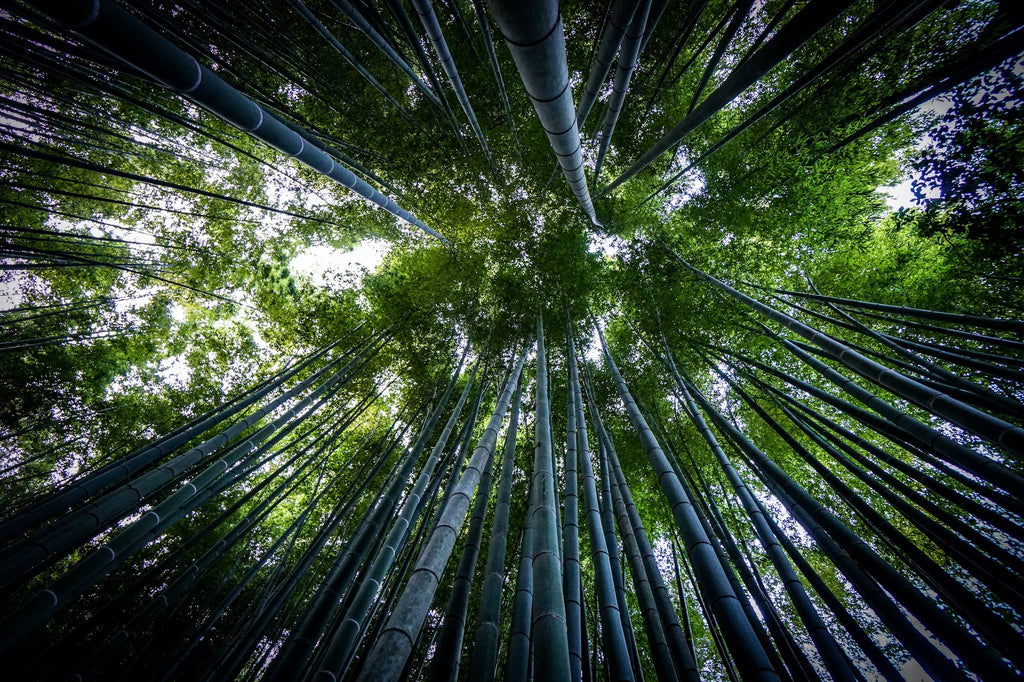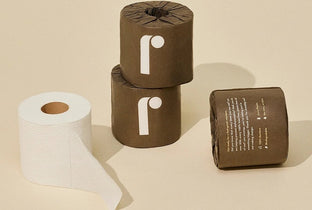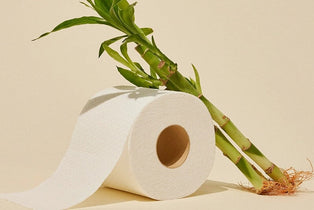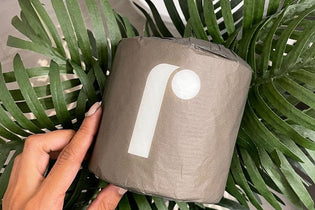
TLDR
Close your eyes and picture yourself inside a bamboo grove. As far as you can see, towering bamboo canes climb upward through the fog. Young leaves happily drink in the sunshine and glow vivid green. Their glossy stalks sway but feel surprisingly sturdy when you reach out to touch them.
In your imagination, you're likely seeing Giant Timber Bamboo, known for its impressive height and emerald sheen. But beyond painting a serene landscape, the bamboo plant also serves many practical purposes, from textiles to paper products like bamboo toilet paper.
What are the different types of bamboo plants? Enter our grove of knowledge to learn the most common bamboo types and discover how this ancient plant can help us create a better future.
What Is Bamboo?
You’ve probably heard of the bamboo plant before. Without realizing it, you likely encounter bamboo every day—in household objects like a mixing spoon handle or woven into your bath towels as fabric. Bamboo plants are versatile and have become a regular part of many homes.
Evergreen and hearty, bamboo (Bambusa) has over 1,000 varieties. Originally found in tropical climates like the lush mountainsides of China, this variety of grass fares well in heat and cold alike. If you were wondering, ‘How fast does bamboo grow?’ harvested bamboo plants regenerate quickly and unharmed, making them an eco-friendly alternative to combat deforestation.
Gardeners and farmers across Asia and South America rejoice at how plentiful and simple these plants are to cultivate. Thanks to bamboo’s adaptability, a genuine alternative to wood is possible.
8 Types of Bamboo and What They’re Used For
Out of more than 1,000 bamboo species, we’ve chosen eight to look at more in-depth. Encompassing these eight bamboo types are two main categories, known as running bamboo and clumping bamboo. While clumping bamboo plants typically grow outward from a central stem, running bamboo plants can spread quickly and are often considered an invasive species. From the ubiquitous Moso bamboo to the eye-catching black bamboo, let’s learn more about what makes each bamboo type unique and valuable.
#1 Giant Timber Bamboo (Phyllostachys bambusoides)
Boasting powerful height, these plants are beloved in Japan for their usefulness and may be the future of construction. Just gaze up at their massive canopy and imagine the possibilities.
Here’s what sets this bamboo type apart from the rest:
- Giant Timber can grow more than 70 feet tall in sunny, fertile conditions. This provides impressive length for projects of all sizes.
- Culms (the plant’s stems) are thick and sturdy, but simple enough to reshape without expensive equipment. This makes them an accessible building material that isn’t difficult to work with.
Beyond their incomparable height, Giant Timber Bamboo is quite easy to maintain with some moderate watering and regular exposure to full or partial sunlight. Thanks to its massive size and tendency to grow in tightly-packed bamboo bunches, giant bamboo is the perfect choice for:
- Homeowners who’d prefer to have a bit more privacy from nearby neighbors. Grow it as a privacy wall or use it in place of a privacy fence.
- Even if your home is nestled away and off the beaten path, choose a sunny spot in your garden for giant bamboo to grow tall and wide. Use it as a bright backdrop against some sun-loving flowers for a unique landscape design that’ll surely shine.

#2 Moso Bamboo (Phyllostachys edulis)
Sprawling across China and Japan, the Moso plant’s diminutive leaves frame stately stalks of pearly green. This is the most common bamboo species and can be found throughout manmade and natural environments worldwide.
Aside from being the inspiring subject of many a photo, Moso bamboo has several practical uses:
- Moso plants are primarily used for paper pulp. They produce thick, soft paper products that can replenish dwindling wood resources caused by deforestation. Look for it as a primary ingredient in bamboo paper products like toilet paper, paper towels, and paper napkins.
- This type of bamboo can also be compressed into plywood and used as a sustainable replacement for traditional flooring. If you’re ready to rip up your carpets in favor of bamboo flooring, look to Moso bamboo—a sustainable choice typically available in various shades.
- Gardeners looking for a truly dramatic variety of ornamental bamboo will appreciate this plant’s regal height and coloring. Moso bamboo is also the most vigorous bamboo, meaning it can handle colder climates and thrive in all kinds of gardens.
#3 Dragon Bamboo (Dendrocalamus asper)
Sometimes called rough bamboo, this Chinese plant holds up to time and wear. Their distinctly shaped culms feature thick, stacked nodes that give dragon bamboo its dense appearance.
Dragon bamboo is readily available for harvest in countries ranging from Madagascar to Thailand. Local availability of the material reduces transportation energy so that the amount of carbon used to transport materials doesn’t outweigh the benefits of the material themselves. This keeps the process of harvest-to-consumer as “green” as possible.
Aside from the environmental efficiency of this bamboo variety, it can also be put to good use in several other ways:
- Dragon bamboo often becomes kitchen utensils, bathmats, chopsticks, or other household essentials. Bamboo versions of these items tend to be more affordable, biodegradable, and long-lasting, making them an easy inclusion in a greener home.
- Repurpose the cup-like nodes as a watering can or a one-of-a-kind drinking glass.
- Dragon bamboo is also edible. If bamboo is harvested young, this edible shoot and stem make for a tasty addition to soups or can be chopped, pickled, and preserved..
#4 Female Bamboo (Bambusa balcooa)
If females are sugar, spice, and everything nice, this delicious bamboo surely lives up to its name. Preferring wet tropical regions like Indonesia, plants have a thick base culm that sprouts thin leaves further up. This growing bamboo can be found in dense, dark-green clusters that offer tasty shoots and bendable branches.
Female bamboo is a useful tool for the kitchen and crafts:
- Bamboo shoots add delightful crunch and texture to ramen, stir-fries, omelets, and soup. Try pickling an edible shoot for a unique riff on your favorite pickled snack.
- This flexible bamboo is perfect for crafting, especially for constructing woven furniture or baskets.
#5 Black Bamboo (Phyllostachys nigra)
Black bamboo grows prolifically through East Asia, preferring gentle slopes and fresh running water nearby. Eye-catching black culms pop against this slender plant’s bright foliage.
After you’ve spent some time marveling at this bamboo’s stunning appearance, you’ll have more reasons to love it when you consider some of its practical uses:
- Some research suggests that black bamboo has been traditionally used for medicinal purposes. In Japan, it is thought to have been used to manage dry skin and eczema. Each leaf of this variety is also believed to be high in antioxidants, possibly making it useful for targeting free radicals and oxidative stress.
- While black bamboo isn’t structurally sound enough to use as a building material, it can add a decorative touch to any home interior. Frame a mirror or create unique handles for drawers with this plant’s distinctive dark features.
#6 Buddha Belly Bamboo (Bambusa vulgaris ‘Wamin’)
Named for its bulging, belly-like nodes that look adorable enough to tickle, this smaller form of bamboo can be found both outdoors and inside. Originating in Yunnan, besides trickling forest streams, Buddha Belly Bamboo has found its way into the offices, homes, and gardens of those looking to add whimsy to their spaces.
This growing bamboo is one of the only varieties that prefer a pot. Buddha Belly is a perfect introduction to bamboo for the home gardener. Once your plant is situated and happy, you may want to use its fibers for papermaking, boil a bamboo shoot for munching, or even transplant your bamboo outdoors to create a magnificent, short hedge.

#7 Painted Bamboo (Bambusa vulgaris ‘Vittata’)
Perhaps the most recognizable decorative bamboo, this stripey, clustered plant boasts golden culms and vibrant green markings. Pointed leaves offer dappled shade to the weary traveler across native China, India, and Japan.
This green and golden bamboo can be used to add tropical energy to any backyard, whether as a living fence, leaning support for other plants, or backdrop to a patio.
#8 Guadua Bamboo (Guadua angustifolia)
Hailing from South America, this extremely strong variety dominates the American bamboo industry. Guadua prefers volcanic ash in moist soil and grows thick, indestructible culms that are heavily relied upon for sustainable building material. The rhizomes, or sprouts, are sometimes called “Caiman,” the Spanish word for crocodile since they resemble the wetland-loving reptiles.
What’s more, this hardy variety boasts many practical uses:
- Plants can be used to build earthquake-safe shelters and bridges. Such a resource is especially useful in climates that often see monsoons and soil erosion.
- Scaffolding is easily replaceable with Guadua bamboo. The plant’s strength makes it even more viable than lumber—and less of an eyesore.
- Guadua can even be used to produce music. It’s often carved into wind instruments, like flutes, or used in percussion as drumsticks.
Incorporating Bamboo Into Your Home With Reel Paper
By now you have a deeper understanding of the different types of bamboo and their surprising uses. Hopefully, your newfound wisdom will help shape your planet-conscious choices—whether as a chef, builder, or craftsman.
Using Reel Paper’s bamboo toilet paper is another way to work eco-friendly alternatives into your home - we also offer bulk toilet paper so you can enjoy savings while helping the planet. Is toilet paper biodegradable? In short, yes. However, traditional toilet paper still takes much longer to decompose compared to bamboo TP.
Reel Paper strives to make green lifestyle changes simple—compassionate products delivered right to your door. Plus, every sheet of Reel Paper is a slice of dignity for our planet, minimizing toilet paper in landfills while offering soft, fluffy comfort for your skin.
Enjoy virgin-free bamboo fibers, conscious packaging, and absolutely no plastics, dyes, or mystery contaminants. Invest in Reel Paper bamboo paper products today—it’s a simple and rewarding way to show your love for our planet.
Sources:
Bamboo Plants HQ. Phyllostachys Bambusoides https://bambooplantshq.com/phyllostachys-bambusoides/
Bamboo Plants HQ. Phyllostachys Edulis Moso. https://bambooplantshq.com/phyllostachys-edulis-jaquith-moso/
Gardenia. Plant Types. https://www.gardenia.net/plant/phyllostachys-bambusoides
Plants For A Future. Database. https://pfaf.org/user/Default.aspx
Guadua Bamboo. Guadua angustifolia. https://www.guaduabamboo.com/blog/guadua-angustifolia
Plants For a Future. Dendrocalamus asper. https://pfaf.org/user/Plant.aspx?LatinName=Dendrocalamus+asper
Bambu Batu. Bambusa balcooa: Beema bamboo for better biomass. https://bambubatu.com/bambusa-balcooa-beema-bamboo-for-better-biomass/
Journal of Medicinal Plants Research. Potential Medicinal Application and Toxicity Evaluation of Extracts from Bamboo Plants. https://www.ncbi.nlm.nih.gov/pmc/articles/PMC4659479/
Bambu Batu. Buddha Belly: Bamboo of the highest calling. https://bambubatu.com/buddha-belly-bamboo-of-the-highest-calling/
Gardenia. Bambusa vulgaris ‘Vitatta’ (Painted Bamboo). https://www.gardenia.net/plant/bambusa-vulgaris-vittata




0 comments